In today’s fast-paced digital world, customer service indeed plays a vital role in the success of any business. According to a study by Accenture, 89% of consumers have stopped doing business with a company after experiencing poor customer service! This highlights the importance of understanding and empathizing with your customers.
In this blog, we will explore customer empathy statements and how to use them to improve customer satisfaction. We will also provide 30 examples of empathy statements to help you build stronger relationships with your customers. We will conclude this blog with some FAQs to help you fully understand the concept of customer empathy.
So, let’s get started.
What Are Customer Empathy Statements?
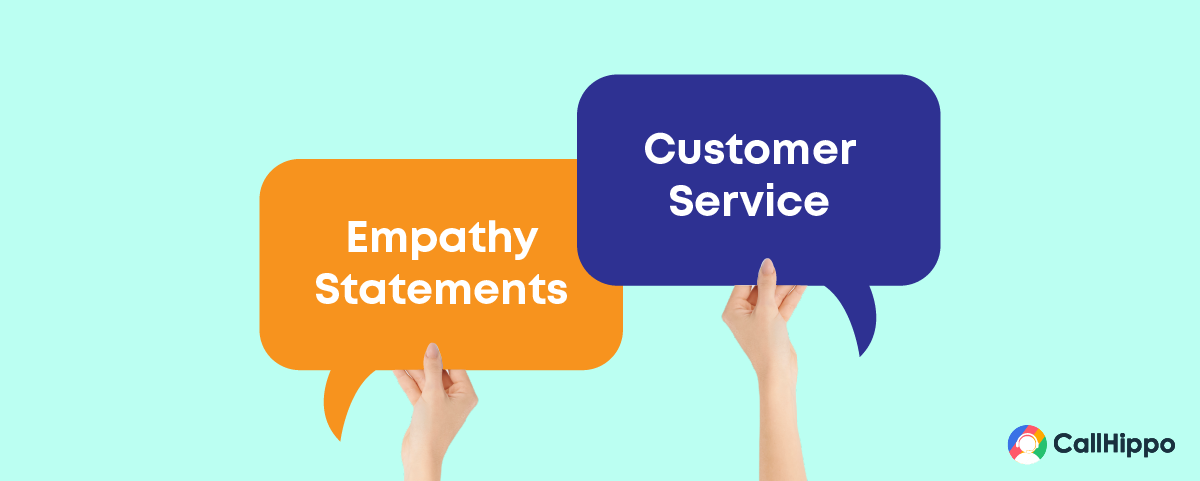
Empathy statements are phrases and words used by customer service representatives to show understanding and compassion toward the customer’s issue or problem. These statements are designed to make customers feel heard, valued, and understood. They are an essential aspect of customer service, and when used correctly, they can significantly help calm irate customers and improve the overall customer experience.
Examples of empathy statements include phrases like “I can understand how you feel” or “I am sorry you are going through this.” These statements show that the customer service agent is actively listening to the customer and is deeply committed to addressing this as soon as possible to the best of their ability.
With such an empathetic approach, a customer support team can certainly de-escalate the situation, calm down angry customers, build trust, and ultimately create a positive customer experience.
for Customer Service

From Frustration to Satisfaction: 30 Empathy Statements For Customer Service
The following are 7 phases and 30 empathy statements for customers that you can use to improve customer satisfaction and strengthen your brand value.
1. Understand The Issue
The first and foremost responsibility of a call center agent is to understand the issue of the customer well. Try to figure out what exactly the customer is feeling about the issue. Put yourself in the customer’s shoes. The next step is to use customer empathy statements like:
#1. “I am sorry you have to encounter this. I can understand what you must be going through.”
#2. “That sounds really challenging.”
#3. “I can see you have been with us for more than X years and the issue you are facing is completely unacceptable.”
#4. “If I were in your place, I would get frustrated too.”
All in all, understanding the issue at hand and using customer service empathy statements are crucial steps in effectively handling customer complaints.
2. Clarify The Situation
What is the potential reason for the issue? Is there a misunderstanding or doubt from the customer’s side? Or some issues from your company’s side? It is important that you know the exact reason behind the issue. At this phase, use customer empathy statements like:
#5. “I am sorry that you have to go through this. It seems like the problem happened because..”
#6. “I understand what you are going through. It happened because…”
#7. “A few of our customers complained about the same. They faced the issue because they [their mistake]. Would you mind checking if you did the same?”
#8. “We recently discovered this issue. This is happening because..”
By identifying the potential reason for the issue, you can provide the customer with a clear understanding of the problem and take steps to address it.
3. Reassure The Customer
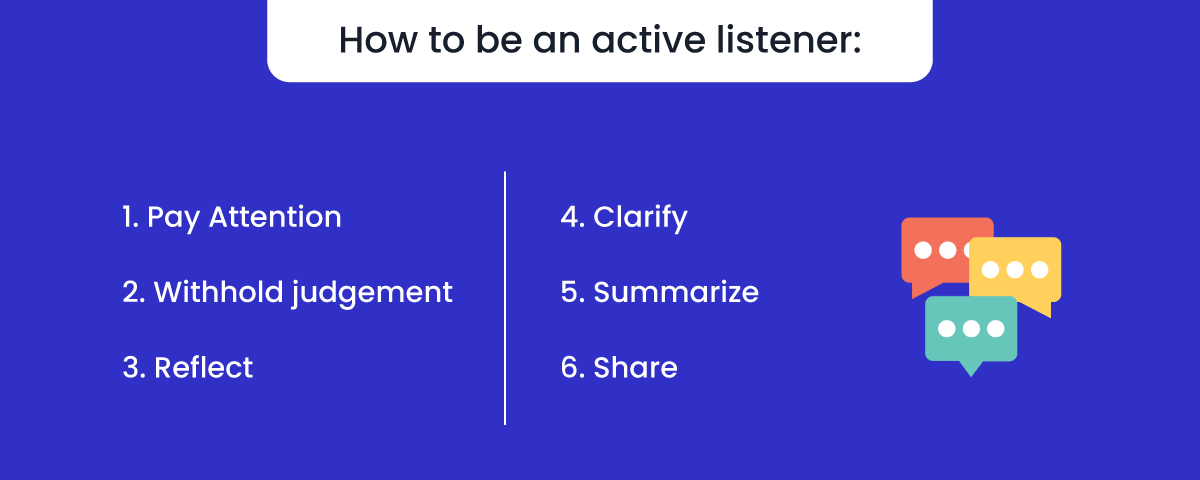
After you have clarified the situation, reassure the customer that you are on the same page, they are valuable to the company and that their problem will be resolved as soon as possible. At this level, you can use customer empathy statements like:
#9. “Thank you very much for letting us know about the concern. We will get it fixed quickly.”
#10. “A few of our customers have complained about the same. We are working on it to make sure that it does not happen again.”
#11. “I will personally ensure that your issue gets resolved at the earliest.”
#12. “I have got the concerned team looking into your problem. I will update you with the status soon.”
In a nutshell, it is important to reassure the customer that you are on the same page, their problem will be resolved as soon as possible, and that the company values them.
4. Provide A Sense Of Swiftness

While reassuring the customer, provide a sense of immediacy. It minimizes customer frustration and calms them down (even the angry customer!). To demonstrate a caring approach, and show a sense of urgency, use empathy statements for customer service like:
#13. “I appreciate your patience, Sir/Ma’am. Please be assured that I’m working on your issue on a priority basis.”
#14. “I am currently working on getting a solution to your problem.”
#15. “We are currently working on your issue, and it will be sorted by the end of the day. I hope that’s not too late.”
#16. “I have recognized the problem, and I have a quick solution for it.”
To sum up, quickness in customer service can greatly improve the customer experience, while empathy statements can help communicate this immediacy during customer service conversations.
5. Make A Commitment
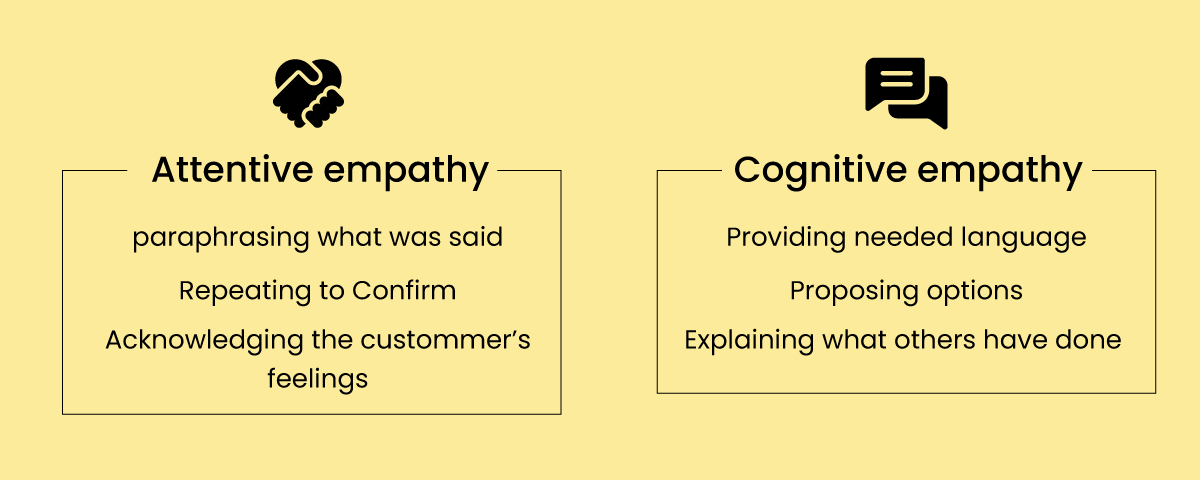
Commitment comforts the customers as it highlights that they are valuable to your company and that their complaints are being resolved on priority. It also gives customers detailed information about the next process. To commit, use examples of empathy statements like:
#17. “I am personally working on your issue, and I will contact you as soon as I have an update.”
#18. “I understand the urgency of the problem. You enjoy your (birthday, holiday, or vacation) and I will contact you shortly.”
#19. “Since you have bought the product from us, we guarantee you, we will fix your issue asap.”
#20. “I really appreciate your patience. Stay assured your problem will be resolved within two working days.”
Remember that committing to resolving customer complaints and using empathetic statements not only comforts the customer and assures them that their issue is being taken seriously, but it also builds trust and loyalty in the long term for your company.
6. Solicit Customer Feedback

Gathering customer feedback is essential to improving customer service and building stronger relationships. Use empathy statements to encourage customers to share their honest thoughts on the overall call and the process.
#21. “I want to make sure we’re meeting your needs. Can you tell me how you feel about the service you received today?”
#22. “I want to make sure we are doing everything we can to make your experience with us a positive one. Can you give me some feedback on how we handled your issue?”
#23. “I want to make sure we are meeting your expectations. Can you let me know if there’s anything you think we could have done better?”
#24. “I value your opinion. Can you tell me if there’s anything we can do to improve your experience with us in the future?”
#25. “I want to make sure we are providing the best service possible. Can you share your overall thoughts on the call and the process?”
7. End The Call With A Strong Customer Empathy Statement
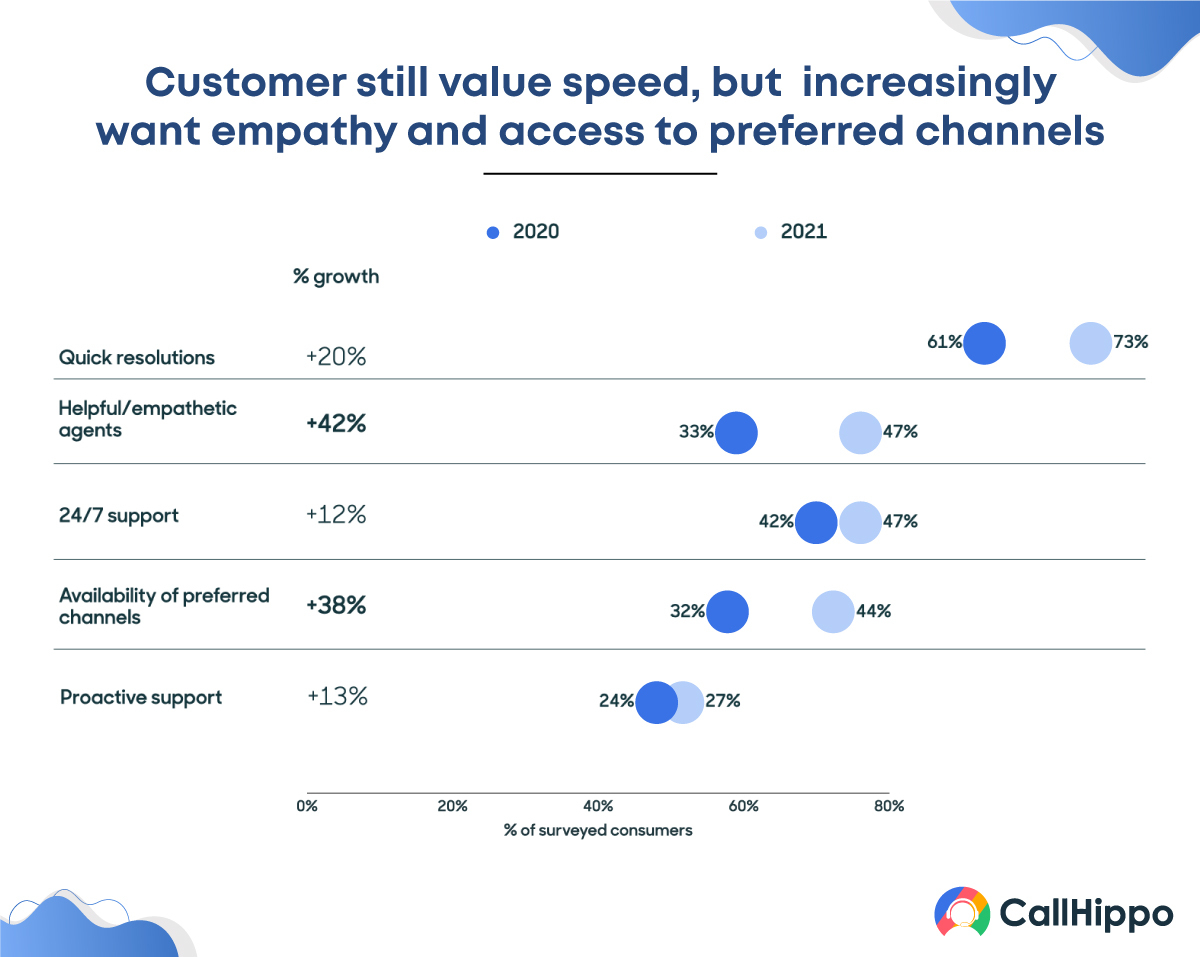
Now that the call is about to end, you should still maintain a positive tone and empathetic attitude. It helps make the customers feel comfortable voicing issues they may still have. While signing off, use empathy statements for customer service like :
#26. “Is there any other issue that I can help you with, Sir/Ma’am?”
#27. “I hope you have got the solution you were expecting. Let me know if you have any other questions.”
#28. “Your satisfaction is our first priority. Have I answered all your queries? Or do you need assistance with anything else?”
#29. “It was my pleasure talking to you. Let me know if I have missed anything or if you have got additional questions.”
#30. “I want to make sure we’ve covered everything. Is there anything else I can help you with before we end the call?”
To sum up, ending the call with a strong customer empathy statement is crucial in maintaining a positive customer experience.
How Do You Empathize With A Customer: 6 Tips
Empathizing with a customer involves understanding and acknowledging their feelings and perspective. Here are a few steps to provide an empathetic response to the upset customer:
Tip #1: Listen actively to the customer’s concerns and complaints.
Tip #2: Show genuine interest in the customer’s problem and their experience.
Tip #3: Validate the customer’s feelings by acknowledging their frustration or disappointment.
Tip #4: Show that you are taking their issue seriously and are committed to resolving it.
Tip #5: Provide clear and concise information about the steps you are taking to resolve the issue.
Tip #6: Follow up with the customer after resolving the issue to ensure their satisfaction.
Overall, remember that the key to empathizing with customers is understanding and acknowledging their feelings and perspective.
7 Most Common Examples of Empathy Statements
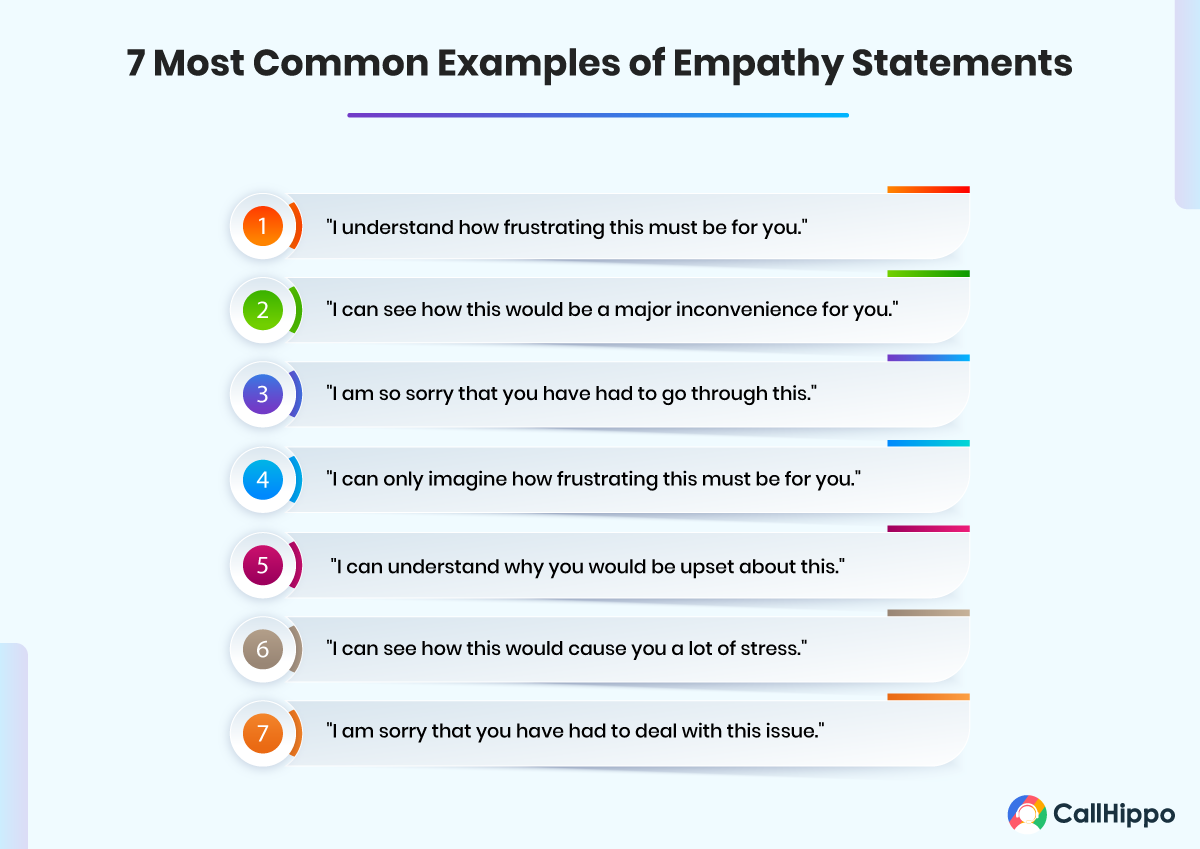
Here are a few most common examples of empathy statements that customer service representatives can use to de-escalate the situation or calm down irate customers:
#1. “I understand how frustrating this must be for you.”
#2. “I can see how this would be a major inconvenience for you.”
#3. “I am so sorry that you have had to go through this.”
#4. “I can only imagine how frustrating this must be for you.”
#5. “I can understand why you would be upset about this.”
#6. “I can see how this would cause you a lot of stress.”
#7. “I am sorry that you have had to deal with this issue.”
With this, we are ending this blog post.
Remember that empathy statements are an essential part in providing great customer service. They show that you care about them– the customers, and eventually help you build trust. Use them as per the situation.
Conclusion: Using empathy statements is one of the most effective ways to improve customer satisfaction and build brand value. Empathizing with customers by understanding their problems and clarifying the situation can ensure the customer feels heard and valued. At the same time, it is critical to choose and use appropriate and good empathy statements that de-escalate rather than escalate the situation. If you are looking to hire a customer service professional for your business to improve customer satisfaction, using a customer service assessment can help you narrow down the best candidates.
FAQs
What are customer service empathy statements?
Empathy statements are phrases and words used by customer support agents to show understanding and compassion towards the customer’s issue or problem. They are designed to make customers feel heard, valued, and understood.
How can empathy statements for customer service be used?
Customer service empathy statements can be used in various forms of communication– including phone calls, emails, and face-to-face interactions.
What are some examples of empathy statements?
Empathy statements include phrases such as “I can understand how you feel” or “I am sorry you are going through this.” These phrases eventually demonstrate that the customer service agent is not only actively listening to the customer but is also deeply committed to resolving the issue to the best of their ability.
How to show empathy to customers over the phone?
To empathize with a customer, it’s essential to actively listen to their problem or issue, understand their perspective, and show compassion towards their situation. One of the most effective ways to empathize with customers is to use empathy statements.
How to empathize with customers over the phone?
When communicating with customers over the phone, it is essential to use a calm and positive tone, actively listen to their problems, and use empathy statements to show compassion.
What is empathy and sympathy in customer service?
Empathy in customer service involves understanding and sharing customers’ feelings and showing genuine concern for their experiences. Sympathy, on the other hand, requires a surface-level understanding of the customers’ problems. Both are crucial for creating positive interactions, building rapport, and effectively addressing customer needs and concerns.

Subscribe to our newsletter & never miss our latest news and promotions.









